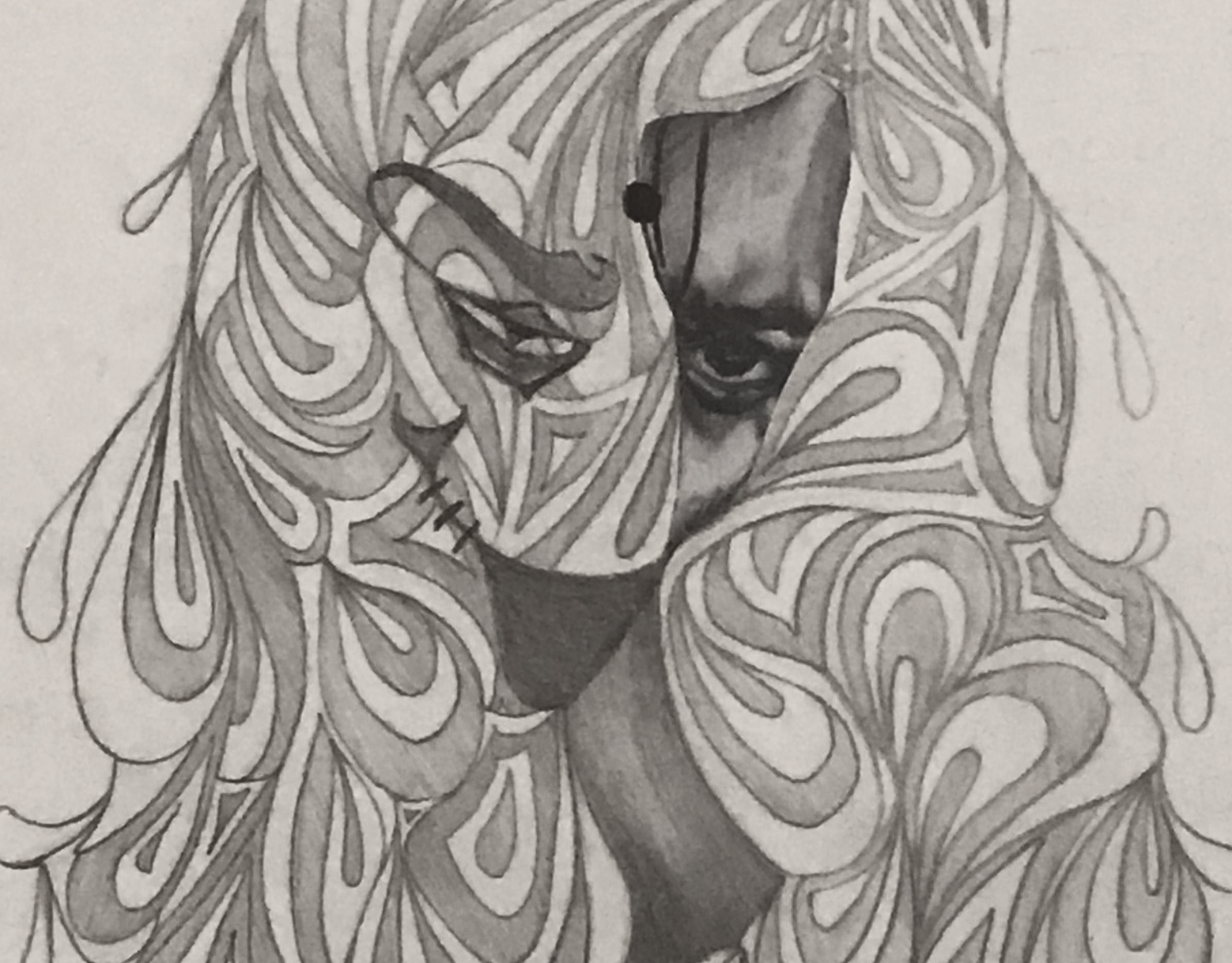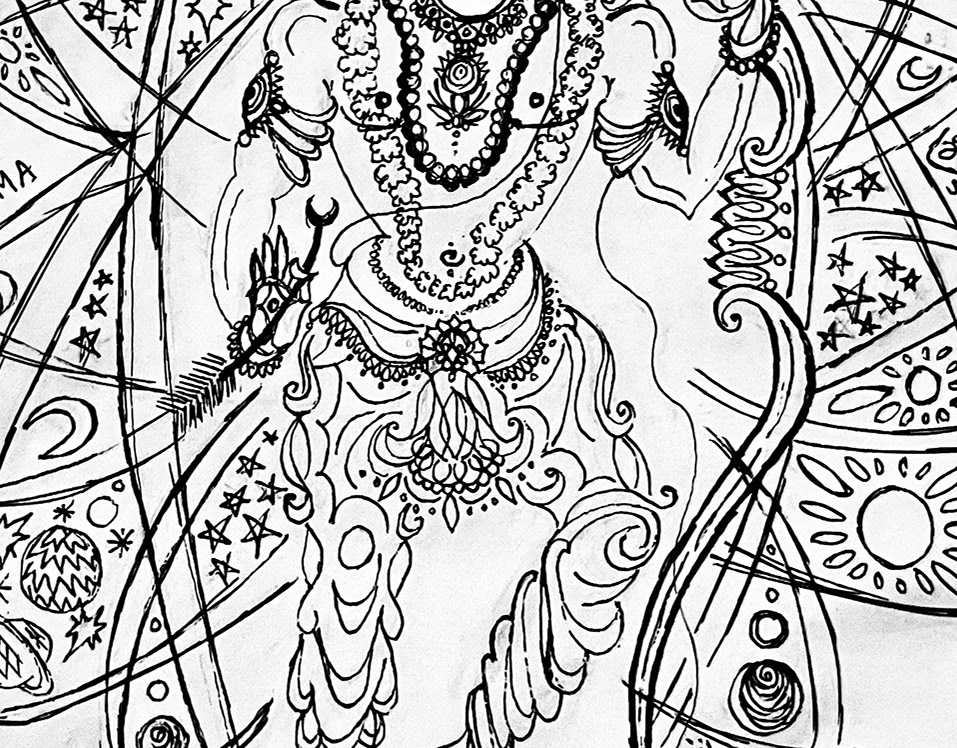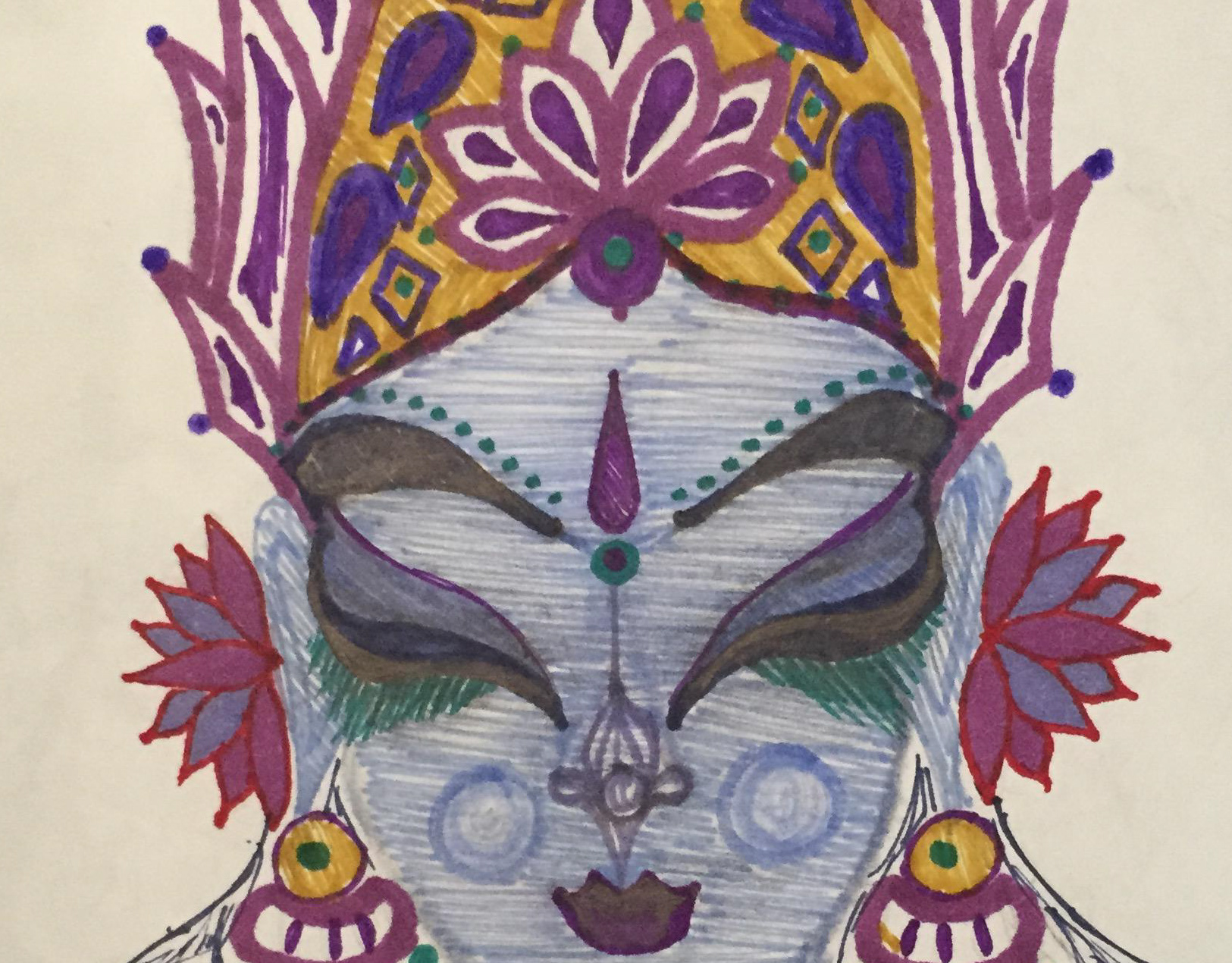“Lantern Night Logo” (2020)
Created using Adobe Illustrator during Visual Design & Digital Making Virtual Summer Intensive, co-sponsored with LITS at Bryn Mawr College. The aim of the piece was to create a logo to represent Bryn Mawr College's annual tradition of Lantern Night. Hence, the college's color scheme of navy with canary and butter yellow. A curvaceous script was drawn to bring a sense of whimsy, in line with the enchantment of lanterns aglow in the dark. Open hands show the acceptance of light and knowledge. The design of the hands was broken up to highlight the palms and fingertips, and the dispersion of light particles is shown with the circles.
More from this Category:

"Outer Animal, Inner Anguish" (2016)
Pencil drawing created for Drawing course. Displayed at Anglo-American School of Moscow. Realistic sliver of a face shows a tortured inner self, fighting for control inside the mind of a monstrous external self, shown with the cartoonish outer eye and stitched smile. A bindi/bottu holds both the external and internal self together, at the seams. The hair is drawn stylistically, with fluid shapes and slight curves fitted next to triangles.

"Flute Choir: Winter Concert" (2022)
Brochure designed using ink. Each piece from the concert repertoire was incorporated. For instance, "Stained Glass Windows" was a general theme, hence the entire piece is framed into a classic, Gothic window. The upper panel represents "March of the Planets," the rose beneath the planets represents the "Roses" piece, and the upper-left panel represents "La La Land: City of Stars," in which Emma Stone dances beside 5-star film ratings and a streetlight (which is reflected on the right panel's border). The upper-right panel contains Georges Bizet's "Carmen" via a sweeping skirt covered with the hearts of men who fall for Carmen. The central plum symbolizes the "Sugar Plum Fairy," the reed flutes lining the lower left and right panels' edges are from the "Dance of the Reed-Flutes," all from Tchaikovsky's "Nutcracker Suite." "March" from "Nutcracker" is combined with the "March of the Toys" piece in a soldier-teddy-bear playing piccolo on the lower right panel. "I Have a Dream" from "Les Misérables" is captured on the lower left panel through the girl from the novel's book cover. Finally, "Treasures Under the Sea" is portrayed through treasure chests and seaweed in the lowermost panel. Bold lines and reflective scripts are used to highlight the concert date as window shutters. The "Bi-Co" or bi-college is similarly kept in thick, sharp angles, with "Winter Concert" script kept in diminishing/growing font. The entire brochure design exemplifies symmetry and harmonious composition.

"Chitrakootha Forest Romance" (2023)
Drawn with ink. Figure on the left is a Hindu goddess, Sita Devi, daughter of the earth. Figure on the right is Sri Rama, the Hindu god of the epic "Ramayana." Here, in the Chitrakootha forest, we see Sita playfully stealing Rama's quiver of arrows and twirling one arrow out of Rama's grasp. Rama holds Sita's waist and shoulders his bow. Intricate linework shows the movement of the arrow, leaves and flowers stitched into Sita's skirt, jewelry, and crown, and lotus flowers in Rama's pants. He wears a thread and prayer beads around his body, and the fabric tied around his waist shows his sweeping movement towards Sita. The marks of divinity are on Sita and Rama's foreheads; they are surrounded with halos and hearts. Thicker lines outline key features of their bodies, and their hair is elaborately styled. The thin, simple bowstring is meant to contrast with the details of their garments. Their feet and faces are drawn stylistically, to show loving gazes and surreal beauty.

"Universe, Balance: Rama" (2023)
Created with ink, draft (scroll down) created with pencil. This illustration depeicts the Hindu god Sri Rama as the center of the universe, providing balance between opposing sides. He carries an arrow (with a crescent-shaped head, similar to that of ancient Indian arrows, which had different shapes) and bow whose string curls around his arms. His crown, belt, and jewelry indicate his status as a warrior king, and a sun-like halo surrounds his head. His forehead is covered in the symbol of the god Vishnu, whom he is the incarnation of. His pants are drawn stylistically to show draped silk. His feet have small sparks next to them. He is surrounded by a structure which contains suns and moons, planets and stars. Rama's name, in English, Telugu, and Hindi, is written amongst these parts of the universe. The structure symbolizes both the universe and an atom: to suggest that Rama is present in the largest scale and smallest scale. In this illustration, centering him within the smallest particle is a reference to Telugu poet Annamacharya's writing on the same subject. Finally, the sacred syllable "Om" outlines the structure. Note: This piece was intended to be the first in a series of illustrations for a devotional kirtan (song) about Rama, written by the late Dr. Advikolanu Muralidhar. So, this imagery reflects the lyrics. This style of art is inspired by the Vedic Art style, hence the curved body of the male figure, the oval-shaped face, and elaborate ornaments.

"Fall of Free Expression" (2015)
Watercolor and ink painting depicting the threat to freedom of expression in the world, in society, in culture, and under oppressive governments. This freedom is crumbling and reflected in the shadows of vulnerable, multicolored dominoes. This piece demonstrates use of a vanishing point beyond the page.

"Peacock Deities" (2020)
Drawn in ink. Commissioned for a couple's anniversary: the wife was named for Vidhya Devi or Saraswati, the Hindu goddess of wisdom (figure on the right); the husband was named for Kumara or Karthikeya, the Hindu god of war (figure on the left). Both Kumara and Vidhya have a peacock as their vehicle, so the peacock was used as a unifying symbol between the figures. Vidhya is shown with lotuses by her ears, carrying a veena, a stringed classical instrument, with a third eye on her forehead to mark her spiritual knowledge. Kumara carries a spear with his father's symbol on his forehead and on the spearhead. They lean towards each other, and the arc of their bodies and their instruments are meant to create a general sense of symmetry with the peacock feathers. They also have halos around their heads. Their limbs are drawn stylistically, in a cartoonish manner. Sharp angles and thick, flowing lines are featured in both their garments.

Executive Summary pg. 1 (2024)
Page 1 of Executive Summary targeted towards potential investors for Bloqcube Inc, a pharma-tech start-up. Designed using Adobe Illustrator, with arrows from company logo to emphasize transition towards new software and to keep eyes moving across the page.

"Portrait of a Russian Girl" (2016)
Drawn with pencil. The focus of this piece was to draw human eyes, brows, and a nose in accordance to correct proportions and realism. Note the shading, detail in the pupils, and how color is shown despite its absence.

"Savitri" (2019)
Drawn in ink and pencil. This sketch is of the famous South Indian Telugu actress, Savitri (1934-1981) who dominated the South Indian film industry in the 50's and 60's. This illustration of her is taken from a scene in one of her film's songs, in which she stands decked in a sari, her hair adorned with a halo of jasmine flowers, a high hairbun, and a long, signature bottu/bindi on her forehead. She was easily recognizable via her distinct beauty: an oval-shaped face and wide eyes lined with kaatika (kohl). Hence, her style and features were the focus of this sketch.

“Lakshmi: Serene Beauty” (2016)
Sketched with ink markers. Piece depicts the Hindu goddess of beauty and wealth, Lakshmi Devi. Two lotus flowers are tucked behind her ears, and her golden crown contrasts with the blue tone of her skin. Lakshmi is symbolically shown with blue skin to indicate that she is the wife of Sri Vishnu (who is also depicted with blue skin in Indian artwork to indicate that his skin is very dark, akin to that of blue rainclouds). Lakshmi's facial features in this peace are meant to bring a sense of peace, and her hair is drawn stylistically in curls.